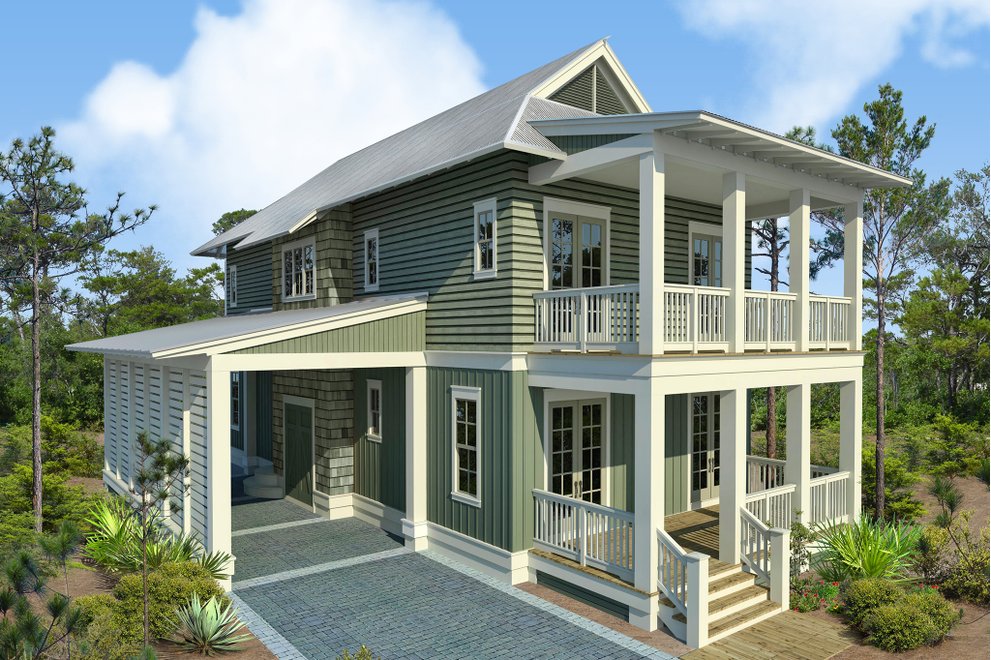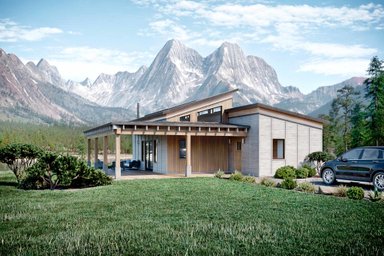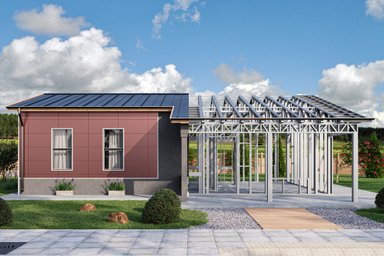Roofs are an essential consideration when planning your new home. They are a substantial investment and there is a wide range of choices. Roofing materials vary considerably when it comes to durability, maintenance and appearance. It is important to understand the features, costs and life spans of each type.
Residential roofs are available in composition shingle, clay tile, concrete tile, and metal. Each one has its pros and cons. We will look at each type in turn.
Composition Shingle
Composition shingles dominate the residential roofing market primarily because of their low cost. The shingles are made up of three layers with a fiberglass mesh layer sandwiched between two asphalt layers. The three tab shingles are the most basic and are available with 20, 25 and 30 year warranties. They have a wind rating to 60 mph. The next level up in terms of cost and durability are laminate shingles. These shingles, also called dimensional, are twice as thick as the three tab shingles. They are made by laminating two layers of asphalt shingles together. These shingles are the best selling shingles on the market. They come with warranties of 30, 40 and 50 years. They are rated for winds up to 130 mph and have a very nice appearance. For an even higher quality composition shingle go to architectural shingles, which are larger and heavier than laminate shingles and come with 50-year or lifetime warranties. Like most compostion shingles, grays and
browns predominate, as shown in these examples from Owens Corning. Again they handle heavy wind loads and look very good on your roof.
When selecting shingles, take into consideration the weather in your area. If you are in a hurricane or tornado prone area, you’ll want to go with the heaviest shingles that you can afford. Heavier shingles hold up better under high wind conditions and last longer.
Clay Tile
Clay shingles are long lasting, require little maintenance and have a class A fire rating. They go well with Mission, Italian and Southwestern designs. They are the most expensive tiles available and cost between $700 and $1000 per square (10’ X 10’ area). They are a life time roofing solution as they can easily last over 100 years. Clay tiles are suitable for use in a warm climate. In colder climates, these tiles are not recommended as the cold air can crack the tiles. The downside to these tiles is their weight. The structure of the house must be designed to accommodate the weight of the tiles. They are also fragile so repairs and maintenance should be done by a qualified roofer. Another important consideration is the underlayment. This layer is what actually waterproofs your roof. Be sure to go with a high quality underlayment and to discuss this subject with your roofing contractor. Tile roofs come in a range of colors from terra
cotta, to greens and blues to white, as shown in these examples from Santa Fe Tile. Lighter colors can reduce your heating bills up to 25 to 30%. Alternatively, darker colors are useful if your house is located in constant shade and you want to transfer heat to the interior.
Concrete Shingles
Concrete Tile is another good roofing solution and can mimic other wood and clay products. Shake
look-alike tiles by Boral Roofing, example, are especially realistic (image courtesy Boral).
Concrete tiles are extremely durable and resist damage from fire, heat, hail and wind. They cost slightly less than a clay tile roof and the tiles weigh less. They last at least 50 years and are usually warrantied for a 50 year period. Some concrete tiles, however, do not do well in cold weather. Concrete absorbs moisture and will crack in very cold weather. Be sure to discuss their temperature rating with your contractor.
Metal Roofs
Metal roofs are also known as Standing Seam can be a very good but expensive roofing solution. They are long lasting, lifetime roofs and stay cooler because they reflect heat rather than absorb it. This saves on energy costs and lowers the lifetime cost of the roof. Metal roofs go well with many house designs. They are also great in snow country because these roofs are excellent at shedding snow. Metal roofs are lightweight and only weigh between 50 and 150 pounds per square. Tile roofs, by comparison, weigh around 900 poundsper square. Metal roofs are available in steel or aluminum with steel being the stronger roofing material. Steel roofs are usually zinc coated and come with an enamel finish. Metal roofs come in a wide
range of colors -- from reds and blues to grays and greens, including standard and low gloss alternatives (image courtesy Drexel Metals Roofing Systems). As with other roofs, the lighter colors stay cooler and reduce your heating bills.
Adding Solar Panels
Composition shingles are the easiest roofs for adding solar panels. Next in difficulty is tile, with heavier tiles easier to work with than thinner, lightweight tile. Thin tile tends to crack when drilling through the material. Metal roofs combine well with rooftop solar because metal roofs last so long that the solar panels will not have to be removed to work on the roof. Metal roofs are a bit more costly for an initial installation as custom stanchions must be fabricated depending on the roof type and slope.
Residential roofs are available in composition shingle, clay tile, concrete tile, and metal. Each one has its pros and cons. We will look at each type in turn.
Composition Shingle
Composition shingles dominate the residential roofing market primarily because of their low cost. The shingles are made up of three layers with a fiberglass mesh layer sandwiched between two asphalt layers. The three tab shingles are the most basic and are available with 20, 25 and 30 year warranties. They have a wind rating to 60 mph. The next level up in terms of cost and durability are laminate shingles. These shingles, also called dimensional, are twice as thick as the three tab shingles. They are made by laminating two layers of asphalt shingles together. These shingles are the best selling shingles on the market. They come with warranties of 30, 40 and 50 years. They are rated for winds up to 130 mph and have a very nice appearance. For an even higher quality composition shingle go to architectural shingles, which are larger and heavier than laminate shingles and come with 50-year or lifetime warranties. Like most compostion shingles, grays and
browns predominate, as shown in these examples from Owens Corning. Again they handle heavy wind loads and look very good on your roof.
When selecting shingles, take into consideration the weather in your area. If you are in a hurricane or tornado prone area, you’ll want to go with the heaviest shingles that you can afford. Heavier shingles hold up better under high wind conditions and last longer.
Clay Tile
Clay shingles are long lasting, require little maintenance and have a class A fire rating. They go well with Mission, Italian and Southwestern designs. They are the most expensive tiles available and cost between $700 and $1000 per square (10’ X 10’ area). They are a life time roofing solution as they can easily last over 100 years. Clay tiles are suitable for use in a warm climate. In colder climates, these tiles are not recommended as the cold air can crack the tiles. The downside to these tiles is their weight. The structure of the house must be designed to accommodate the weight of the tiles. They are also fragile so repairs and maintenance should be done by a qualified roofer. Another important consideration is the underlayment. This layer is what actually waterproofs your roof. Be sure to go with a high quality underlayment and to discuss this subject with your roofing contractor. Tile roofs come in a range of colors from terra
cotta, to greens and blues to white, as shown in these examples from Santa Fe Tile. Lighter colors can reduce your heating bills up to 25 to 30%. Alternatively, darker colors are useful if your house is located in constant shade and you want to transfer heat to the interior.
Concrete Shingles
Concrete Tile is another good roofing solution and can mimic other wood and clay products. Shake
look-alike tiles by Boral Roofing, example, are especially realistic (image courtesy Boral).
Concrete tiles are extremely durable and resist damage from fire, heat, hail and wind. They cost slightly less than a clay tile roof and the tiles weigh less. They last at least 50 years and are usually warrantied for a 50 year period. Some concrete tiles, however, do not do well in cold weather. Concrete absorbs moisture and will crack in very cold weather. Be sure to discuss their temperature rating with your contractor.
Metal Roofs
Metal roofs are also known as Standing Seam can be a very good but expensive roofing solution. They are long lasting, lifetime roofs and stay cooler because they reflect heat rather than absorb it. This saves on energy costs and lowers the lifetime cost of the roof. Metal roofs go well with many house designs. They are also great in snow country because these roofs are excellent at shedding snow. Metal roofs are lightweight and only weigh between 50 and 150 pounds per square. Tile roofs, by comparison, weigh around 900 poundsper square. Metal roofs are available in steel or aluminum with steel being the stronger roofing material. Steel roofs are usually zinc coated and come with an enamel finish. Metal roofs come in a wide
range of colors -- from reds and blues to grays and greens, including standard and low gloss alternatives (image courtesy Drexel Metals Roofing Systems). As with other roofs, the lighter colors stay cooler and reduce your heating bills.
Adding Solar Panels
Composition shingles are the easiest roofs for adding solar panels. Next in difficulty is tile, with heavier tiles easier to work with than thinner, lightweight tile. Thin tile tends to crack when drilling through the material. Metal roofs combine well with rooftop solar because metal roofs last so long that the solar panels will not have to be removed to work on the roof. Metal roofs are a bit more costly for an initial installation as custom stanchions must be fabricated depending on the roof type and slope.






